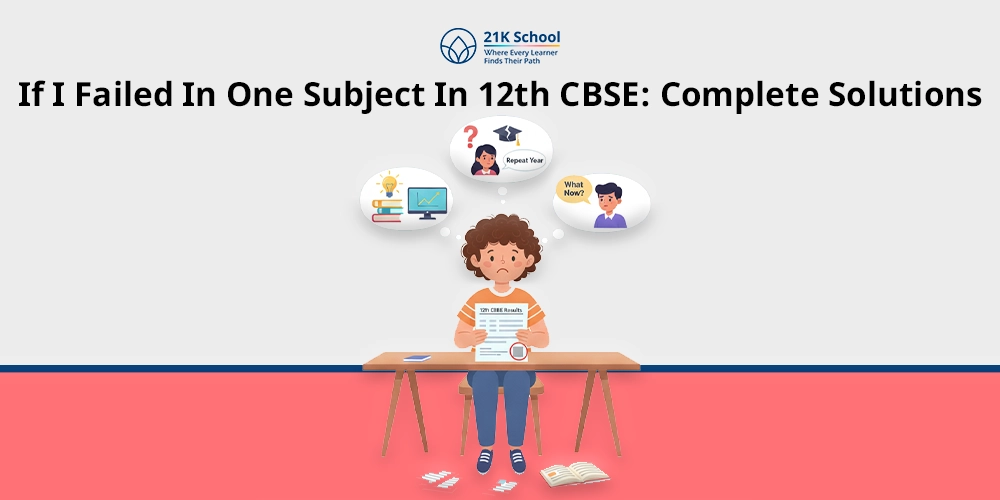
Have you ever imagined what it would look like if you had the option to select a classroom for yourself?
Integrated learning focuses on the multidisciplinary skills that prepare students for future goals. Integrated learning is a methodical approach that connects multiple subjects to create a holistic approach to the learning process.
Through integrated learning, students can make connections between different concepts, knowledge, theories and other information, which develops deeper knowledge.
Integrated learning allows students to develop real-world connections and acquire a comprehensive learning experience.
Integrated learning promotes active learning and combines traditional schooling subjects in order to foster curiosity about learning.
Integrated learning enhances teaching and learning methods through interactive digital materials such as digital projectors, 3D elements, audiovisual elements, gamification and other fun in learning approaches.
This enhances students’ participation and engagement, which allows them to study effectively without any hindrances. Integrated education facilitates the classroom experience and also enhances critical thinking skills.
Table of Contents
What is Integrated Learning?
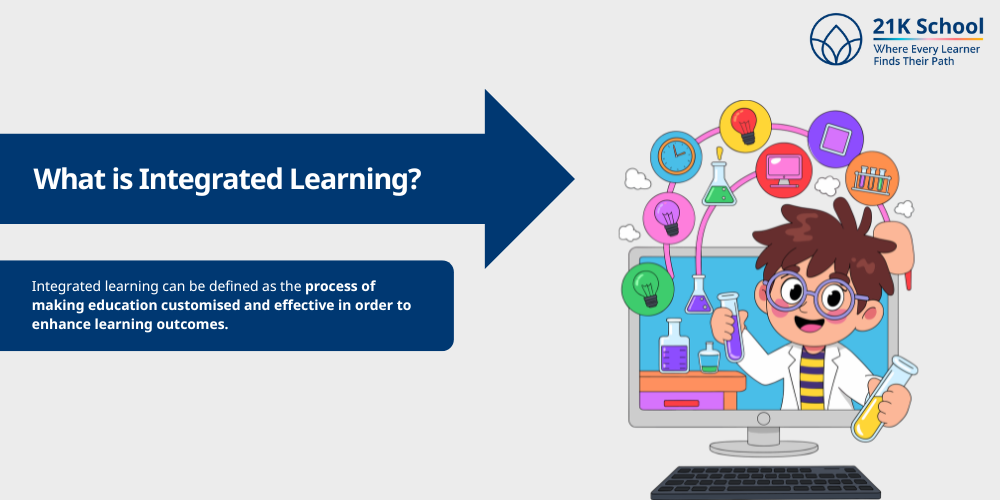
Integrated learning can be defined as the process of making education customised and effective in order to enhance learning outcomes.
Integrated learning, also known as integrative learning or integrated curriculum, is a multidisciplinary teaching and learning approach. It combines different subjects to enhance a deeper understanding of subjects.
Integrated learning helps students to make connections across different subjects and allows them to make relationships between different subjects.
This methodology of learning enhances creative thinking skills and also promotes a collaborative learning environment.
Through collaborative learning, students can understand the concepts of real-world problems and apply the solutions according to the approaches.
As students develop skills in multiple disciplines, it allows them to adapt, cooperate, innovate and generate solutions for complex problems.
The integrated teaching approach fosters creativity and adaptability by bonding concepts from different academic fields together.
Through the interconnected learning across the curriculum, integrated education helps students develop a broad range of skills necessary for future success.
Characteristics of Integrated Learning
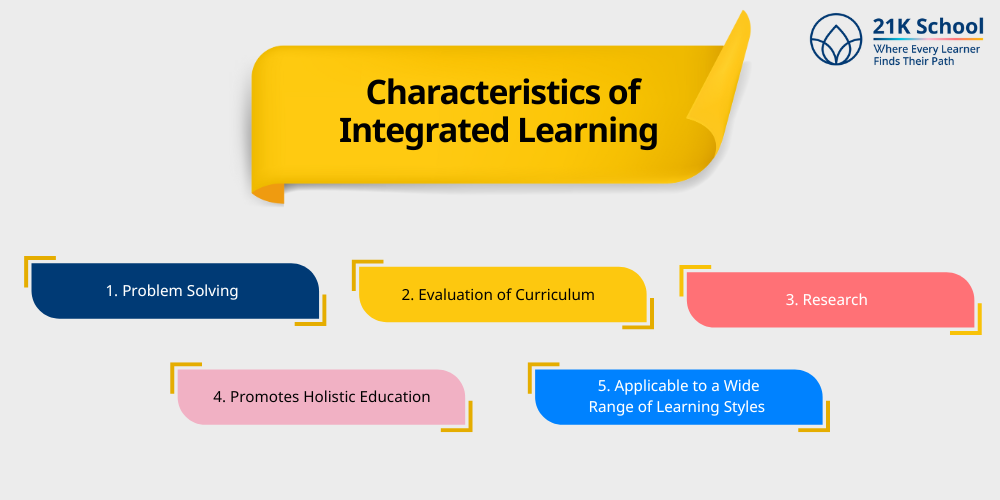
Integrated learning promotes dynamic education by combining different aspects of subjects in order to promote a holistic approach to education.
Integrated learning focuses on making connections between different concepts and experiences. With this information and skills can be applied to a single aspect in order to solve complex issues or challenges.
Integrated learning also helps in promoting inclusive education, where every student can indulge in the education process without any challenges and biases.
Combining multiple curricula and topics allows students to develop confidence and attention, which enhances their problem-solving skills. Below, you can check the characteristics of integrated learning.
1. Problem Solving
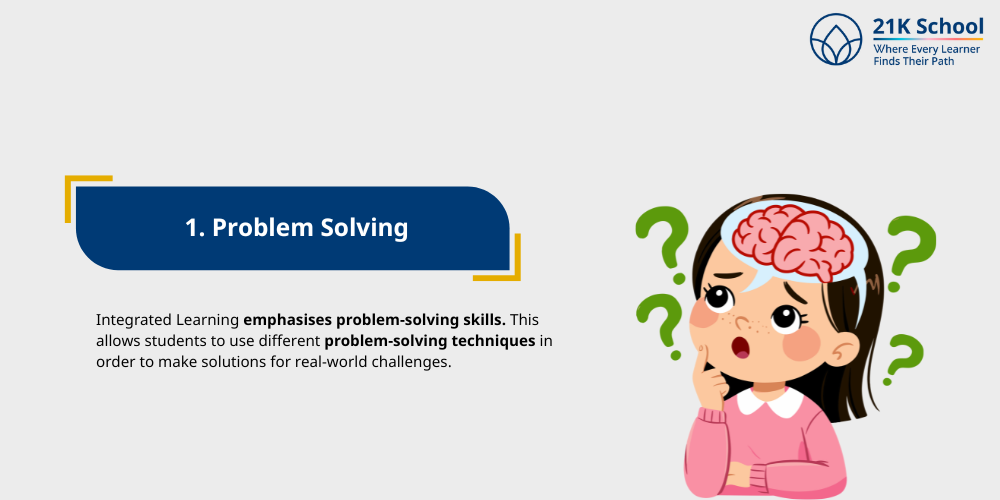
Integrated Learning emphasises problem-solving skills. This allows students to use different problem-solving techniques in order to make solutions for real-world challenges.
Integrated education enhances critical thinking skills and promotes creative thinking skills, which allows students to take challenges as opportunities and develop solutions for complex scenarios.
It also promotes rational thinking as problem-solving is a mental process that provides a structured process.
Through integrated learning, children become adaptable and creative, which assists them in examining different aspects of problems.
2. Evaluation of Curriculum
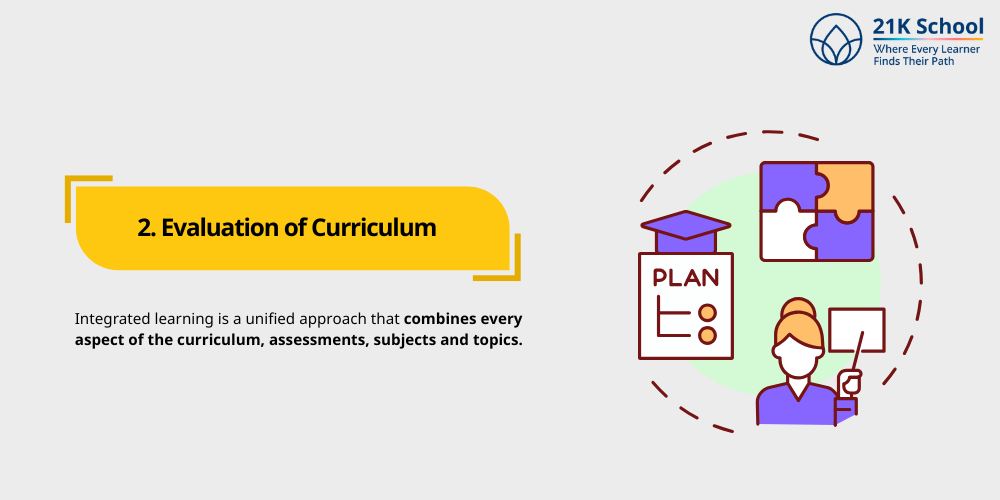
Integrated learning is a unified approach that combines every aspect of the curriculum, assessments, subjects and topics.
This also enables teachers to evaluate and prepare the curriculum based on students’ needs and for professional development.
This methodology also helps in evaluating students’ performance and weaknesses, which allows them to understand their strengths and areas of improvement.
Through synchronous e-learning, students’ practical knowledge can be evaluated, which promotes a unified and comprehensive educational structure.
3. Research
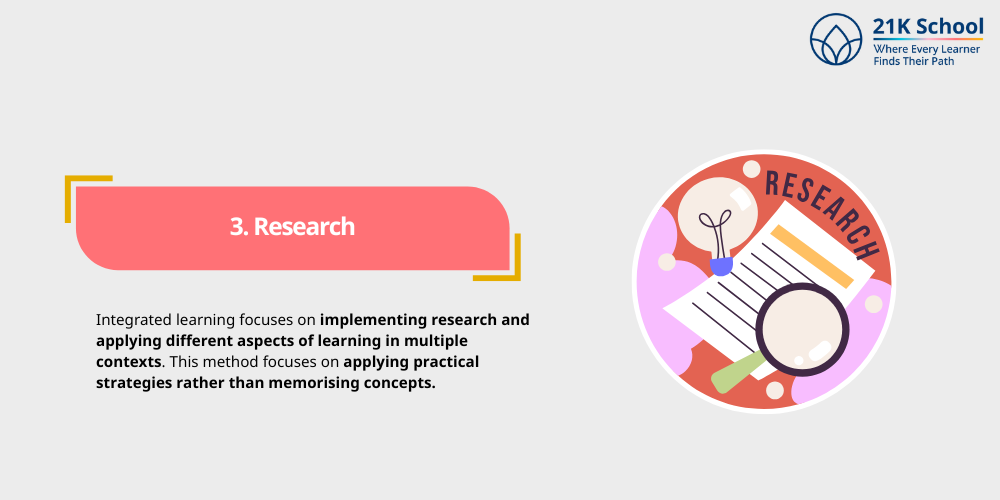
Integrated learning focuses on implementing research and applying different aspects of learning in multiple contexts. This method focuses on applying practical strategies rather than memorising concepts.
This also helps in promoting integrated teaching strategies that assist students in bridging theoretical knowledge and practical, increasing the relevance and impact of learning.
Instead of learning through memorisation, students learn how to find information, evaluate its applicability and use it to solve problems or questions.
4. Promotes Holistic Education
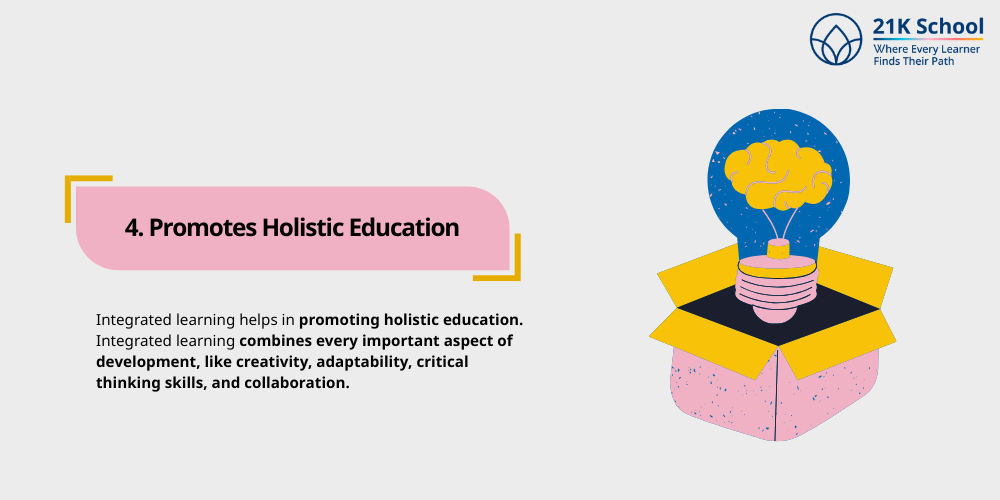
Integrated learning helps in promoting holistic education. Integrated learning combines every important aspect of development, like creativity, adaptability, critical thinking skills, and collaboration.
These important aspects of integration allow individuals to work collaboratively and solve problems with teamwork. Students can work collaboratively through online group projects, field work, social work, projects, etc.
This helps them to develop different perspectives on solutions and analyse the contrast of the challenges.
5. Applicable to a Wide Range of Learning Styles
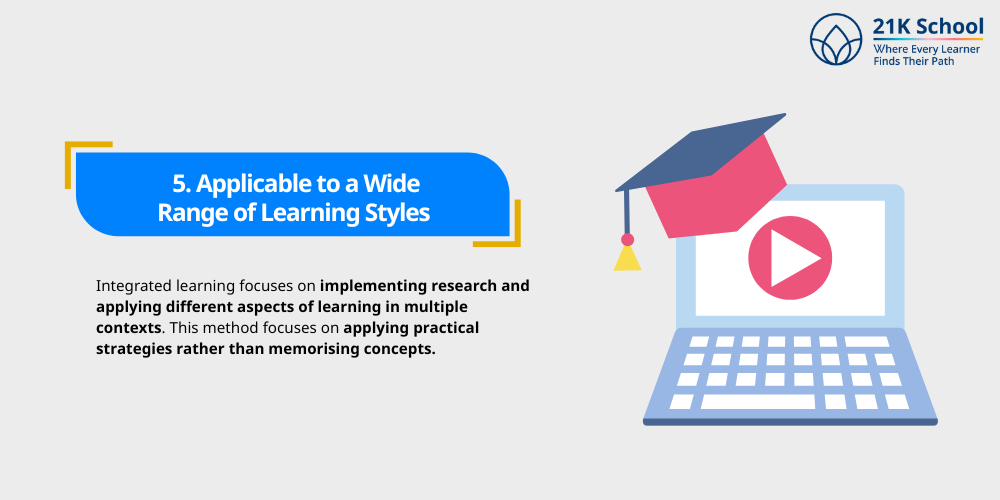
One of the major characteristics of integrated learning is that it accommodates different learning styles.
Every student has their own learning style and capacity, and integrated education gives students a personalised learning experience which strengthen their learning capacity.
This also helps in promoting inclusive education, where every student can study irrespective of challenges. The multidisciplinary learning style enhances students’ visual thinking, logical thinking, and linguistic abilities.
Benefits of Integrated Learning
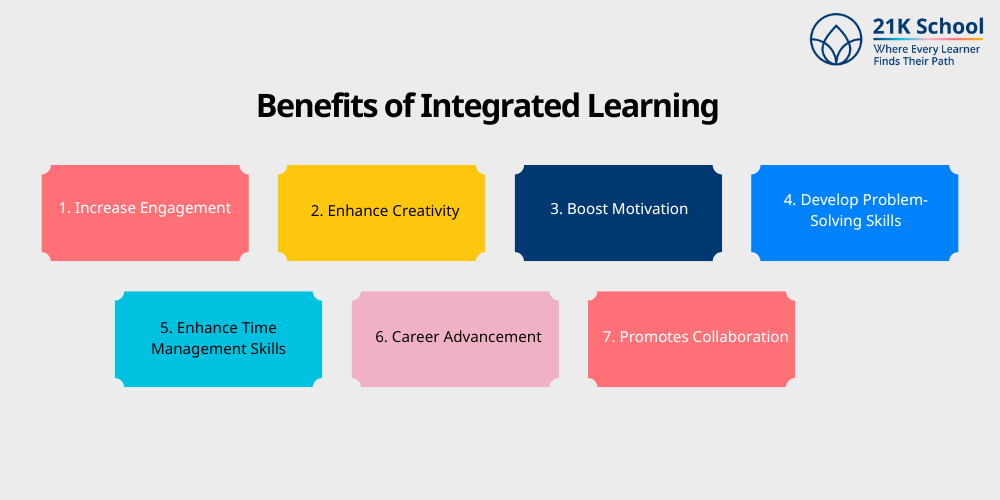
Integrated learning makes students more active and develops curiosity among them.
Integrated learning brings students from different backgrounds together, which promotes a positive learning environment and makes education more versatile.
Through integrated learning, students can combine different aspects of subjects into a single one that makes education more impactful and strengthens the learning materials.
Here you can refer to the benefits of integrated learning mentioned below.
1. Increase Engagement
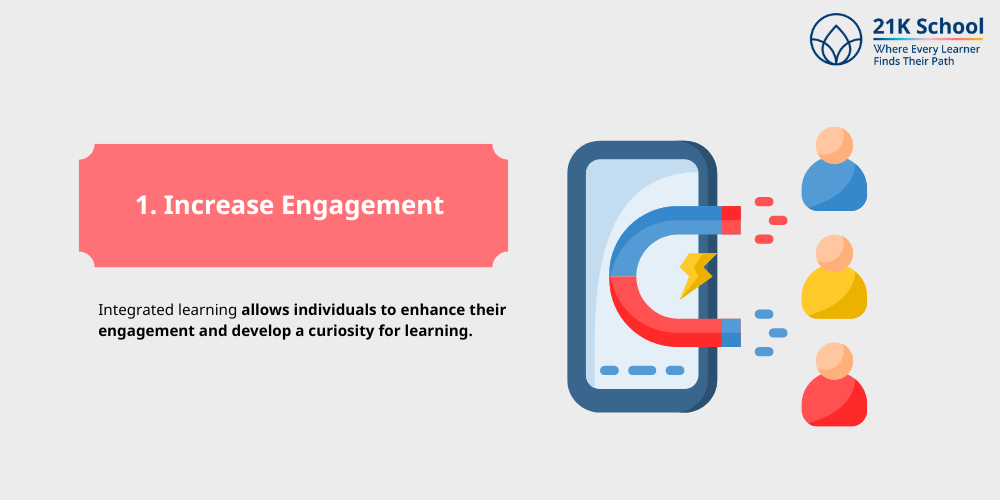
Integrated learning allows individuals to enhance their engagement and develop a curiosity for learning.
Integrated education provides a structured and interconnected learning experience which develops a sense of cooperation among them.
Through the integration of subjects, students can understand the connection between different subjects and their application. This enhances students’ involvement and creates solutions for real-life scenarios.
2. Enhance Creativity
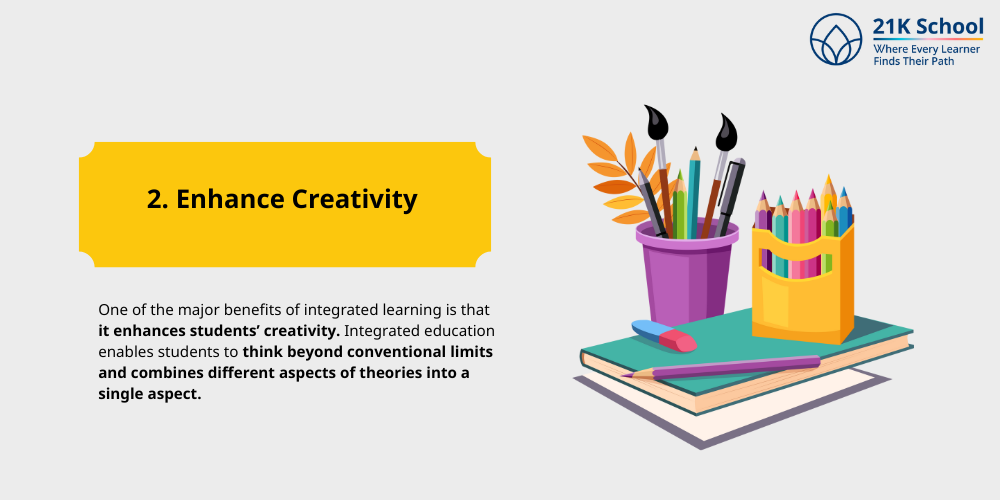
One of the major benefits of integrated learning is that it enhances students’ creativity. Integrated education enables students to think beyond conventional limits and combines different aspects of theories into a single aspect.
This makes learning easier and helps in grasping difficult concepts. This gives them autonomy to work together and share their learning experience.
Integration of subjects enables children to foster new ideas, makes students innovative and develops an entrepreneurial mindset. Through this, they take challenges as opportunities instead of hindrances.
3. Boost Motivation
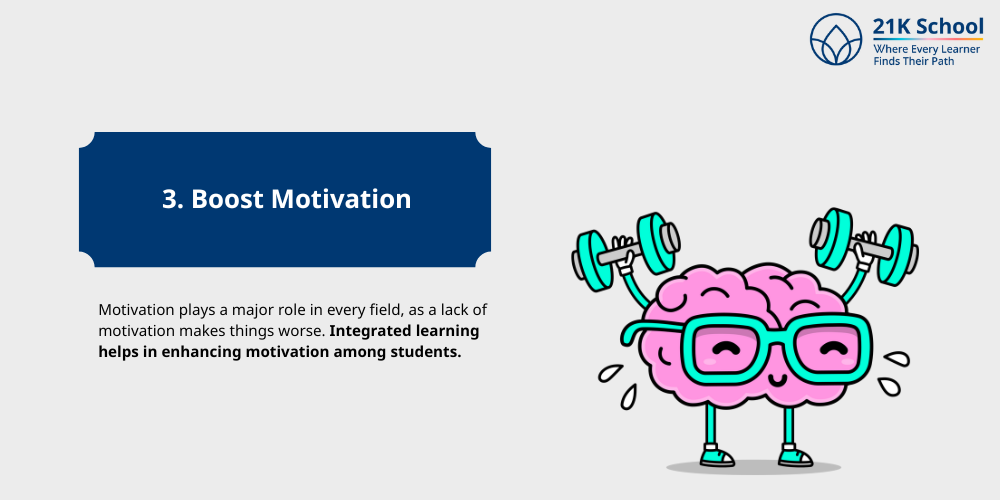
Motivation plays a major role in every field, as a lack of motivation makes things worse. Integrated learning helps in enhancing motivation among students.
Through integration of subjects and topics allows students to explore real-world scenarios and how they are changing the thought process.
Integrated education allows students to boost their motivation and enhance students’ performance for better academic opportunities.
4. Develop Problem-Solving Skills
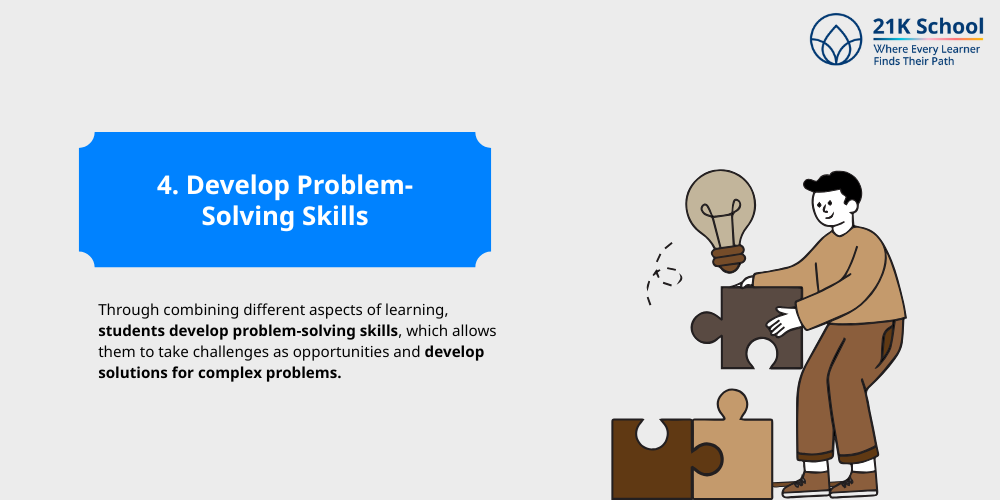
Integrated education increases students’ motivation and sense of purpose, which will make their education more relevant and useful.
Through combining different aspects of learning, students develop problem-solving skills, which allows them to take challenges as opportunities and develop solutions for complex problems.
Problem-solving skills enable students to find different solutions for multiple problems. Integrated learning promotes productivity and encourages students to participate in class activities.
5. Enhance Time Management Skills
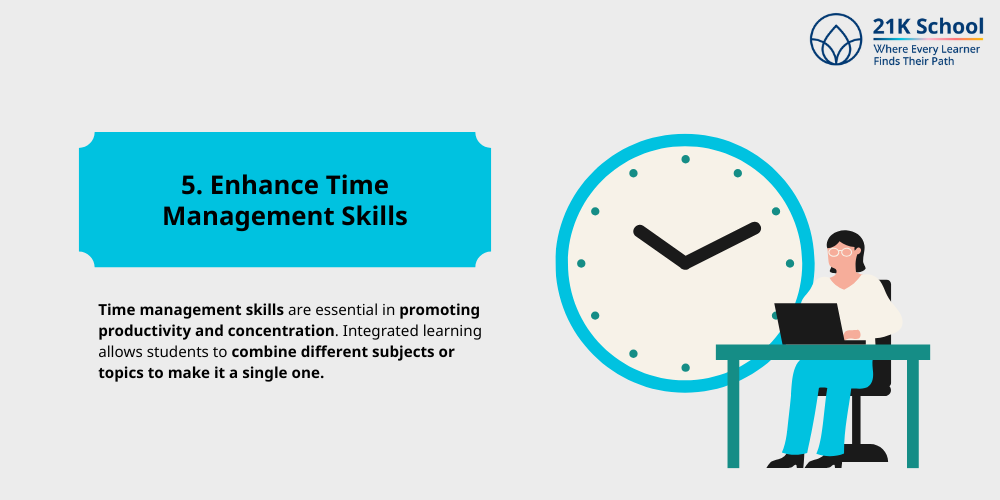
Time management skills are essential in promoting productivity and concentration. Integrated learning allows students to combine different subjects or topics to make it a single one.
This allows students to focus on a subject for a longer period of time and reduces their learning time. Through this method, students can learn complex topics in a simpler and quick way, which makes students time-efficient.
The methodology of integrated learning reduces the involvement of the teaching and learning process and emphasises self-paced learning.
6. Career Advancement
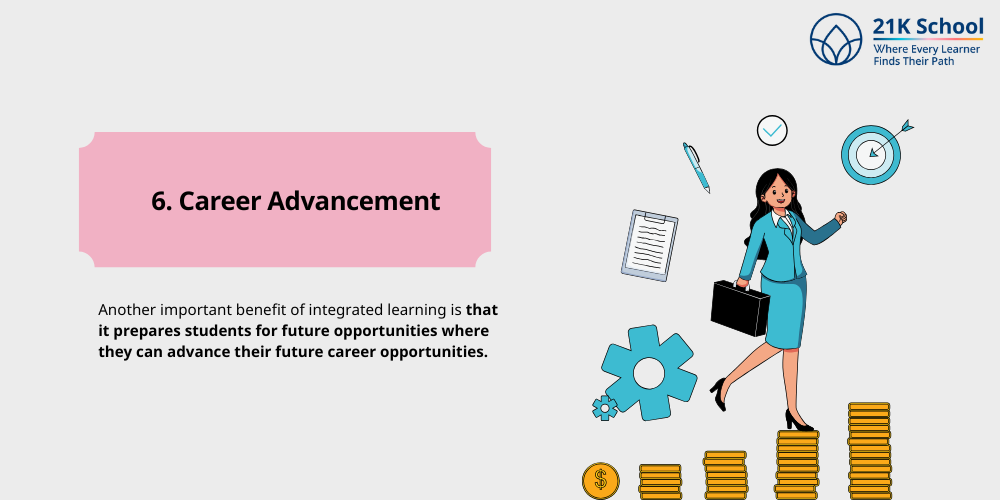
Another important benefit of integrated learning is that it prepares students for future opportunities where they can advance their future career opportunities.
Integrated learning provides more appropriate and structured education.
Through which students are better prepared for the workforce and their future careers. Students who study multiple subjects combined are better prepared for the job market and achieve greater success in their professional fields.
Through this approach, they can comprehend how these subjects can be applied in real-life scenarios.
7. Promotes Collaboration

Integrated learning allows students to work collaboratively through group projects, assignments, field trips, etc. Integrated learning aids in strengthening relationships among students, which promotes peer-to-peer learning.
Integrated learning allows students to make connections between different aspects and allows them to explore practical aspects. This enables them to develop a positive mindset and makes them active participants in every field.
The benefits of collaborative learning allows students to work together and develop sympathy and emotions towards each other.
How Integrated Learning Helps Teachers?
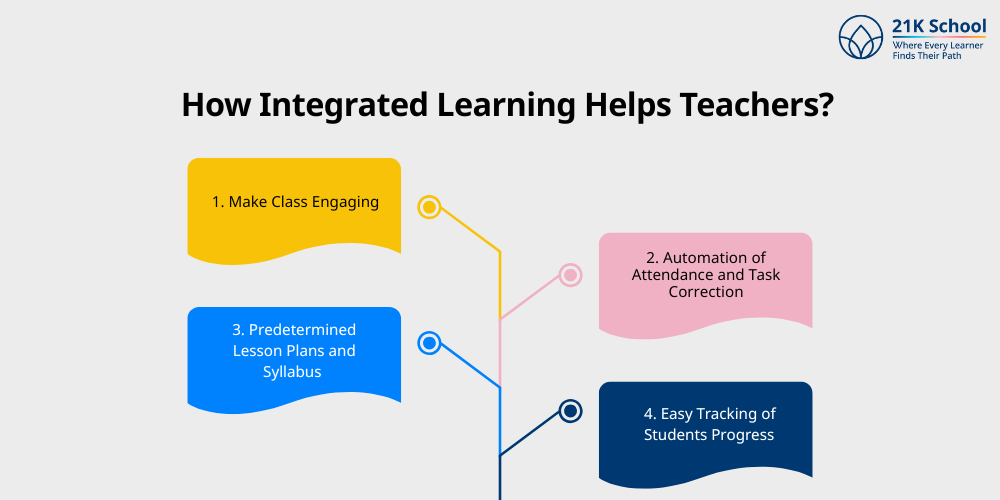
Integrated Learning is not only limited to students and academics, but it also helps teachers. Integrated learning allows teachers to distribute their workload and use effective teaching methods to make learning easier and flexible.
Integrated education helps in making education automated, where students can learn according to their own learning pace. Through integrated learning, teachers can evaluate students’ strengths and weaknesses.
This helps teachers to focus on students’ needs and provide them with tailored content. Below, you can check how integrated learning helps teachers.
1. Make Class Engaging
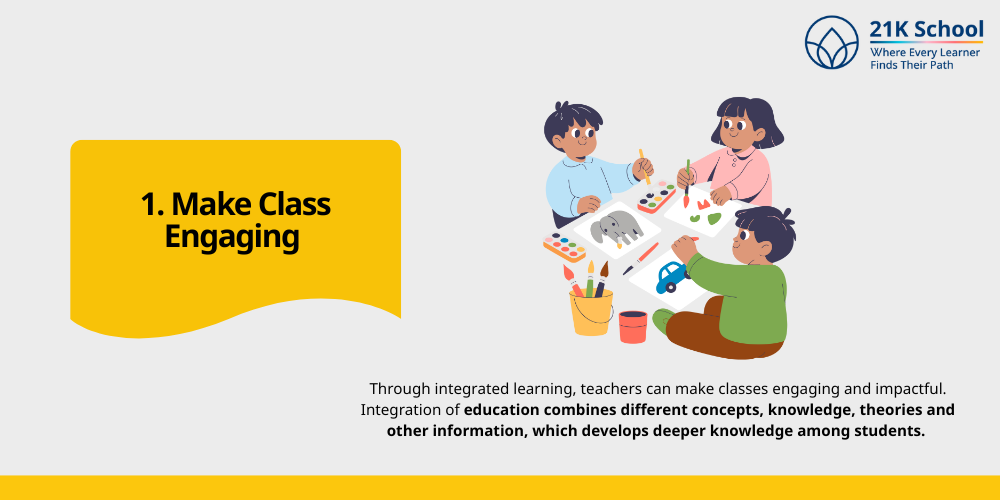
Through integrated learning, teachers can make classes engaging and impactful. Integration of education combines different concepts, knowledge, theories and other information, which develops deeper knowledge among students.
Through this, students can relate real-life skills and coordinate their exam aspects. Integrated learning allows students to use digital tools and resources, which makes education interesting and engaging.
Even educators can teach their students more efficiently, which saves time and reduces workload.
2. Automation of Attendance and Task Correction
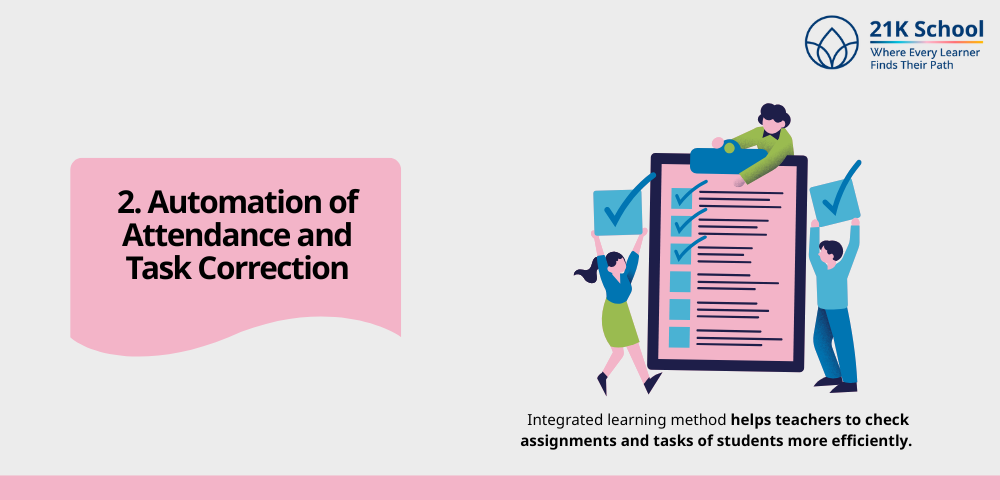
Integrated learning method helps teachers to check assignments and tasks of students more efficiently.
Integrated learning simplifies the learning process through which teachers can conduct exams and assignments through formative assessment tools with the help of MCQ and project work.
Through this, teachers can receive quick feedback, which helps in understanding the weaknesses and improvements of students. As the regular method of traditional schooling is a time-consuming process, teachers have to check entire assessments individually.
3. Predetermined Lesson Plans and Syllabus
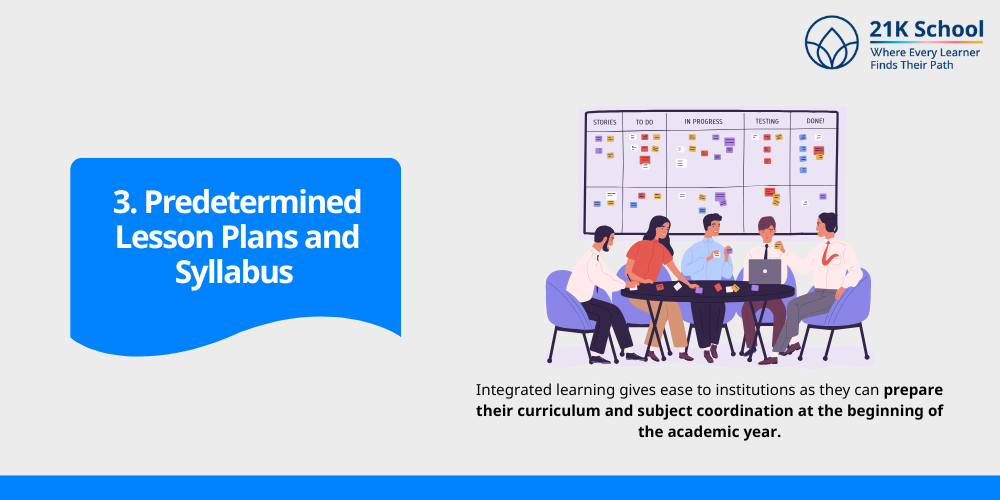
Integrated learning gives ease to institutions as they can prepare their curriculum and subject coordination at the beginning of the academic year.
Unlike a fixed system of education and curriculum, integrated learning gives flexibility to educators.
Once the curriculum and syllabus are decided, teachers can focus solely on giving instructions and their students’ learning outcomes. This helps in enhancing teacher-student relationships, and teachers will have a plan for the entire year.
Every school and educational institute can prepare its academic curriculum with the help of integrated learning.
4. Easy Tracking of Students Progress

Through integrated education, teachers can easily check students’ progress with the help of formative assessment tools and digital resources.
Through integrated learning, teachers can evaluate students’ homework, assignments, project work and exam results.
This allows them to understand the weaknesses and improvements of students, through which they can give extra focus to their studies. Integrated learning allows teachers to receive quick feedback about students’ progress.
According to the feedback, teachers can set remedial classes for students to clear their doubts and help them to enhance their learning outcomes.
Challenges in Integrated Learning and Possible Solutions
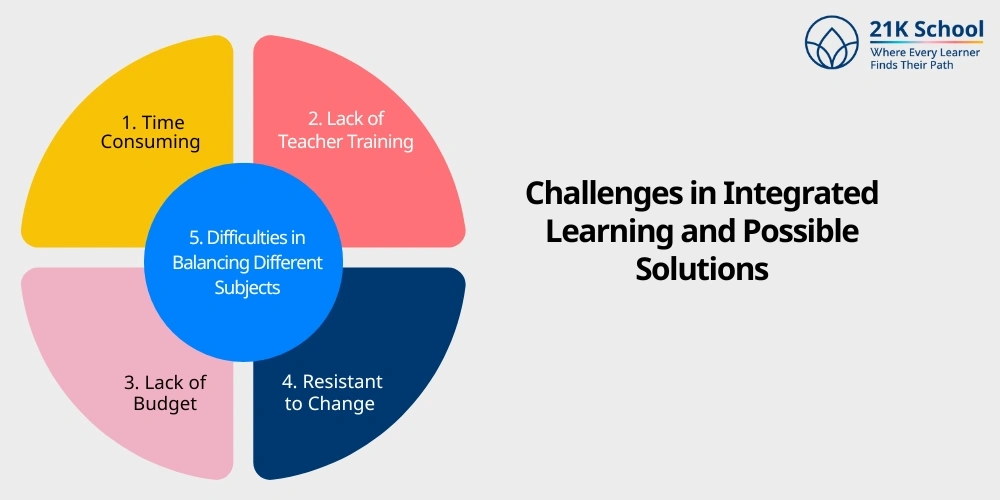
Integrated learning helps in enhancing learning outcomes and making education more effective. This approach gives flexibility to students as well as combines different subjects and concepts into a single one.
This approach helps students to learn the contexts from real-world solutions and analyse the contrast of the challenges. However, along with so many benefits, integrated learning faces so many challenges.
These challenges hindered its true potential and made learning more difficult and challenging. Here, you can refer to the challenges in integrated learning.
1. Time Consuming

Integrated learning consumes more time as combining different topics into a single unit takes more time. This approach needs detailed analysis of learning, and this requires more time as compared to other aspects.
Due to the busy schedules of teachers and students, it becomes tough to complete the syllabus on time. Due to time consumption, it also reduces the learning efficiency of students.
Solution to Tackle Time Consumption
The challenge of time consumption can be avoided by better preparation, effective planning and using technology in education helps in making learning more efficient.
Breaking down topics into smaller parts helps children complete their studies on time without any delay.
Even proper planning and a structured environment help teachers save their time. The importance of time management for students allows them to complete their task on time.
2. Lack of Teacher Training
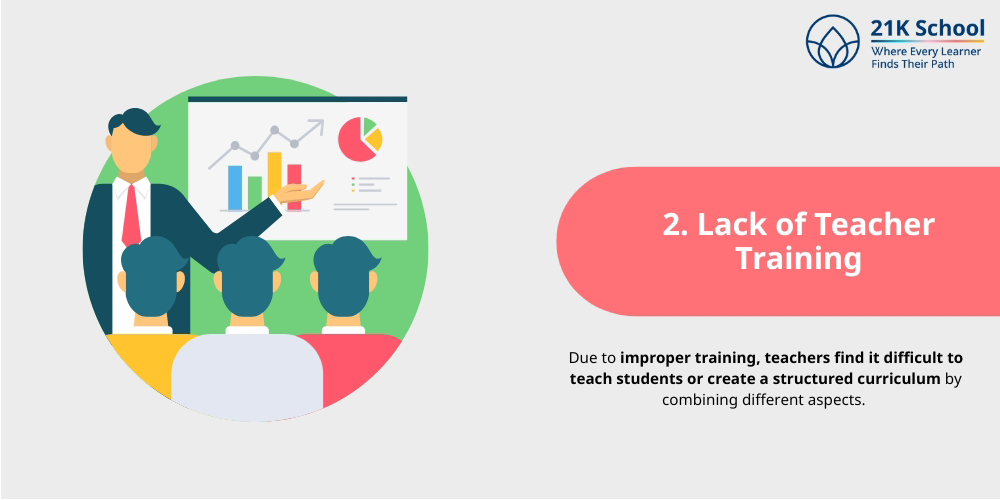
Lack of training is the most common challenge to implementing integrated learning. Due to improper training, teachers find it difficult to teach students or create a structured curriculum by combining different aspects.
Due to a lack of training, students also find it difficult to connect with their teachers and participate in the teaching and learning process.
However, integrated learning is not a new concept, but teachers find it difficult to adjust to the process.
Solution for the Problem of Lack of Teacher Training
The problem of a lack of teacher training can be solved by providing teachers with adequate skills and training.
Providing teachers with ongoing training and promoting skill development programs allows them to acquire the necessary skills. This strategy builds an integrated learning experience among educators.
3. Lack of Budget

Lack of budget is another major factor that hindrances the integrated learning process. Due to budget constraints, educational institutions find it difficult to implement integrated learning in the class curriculum.
Even though it becomes tough to design a new curriculum and hire teachers. Due to budget issues, it becomes tough for educators to allocate proper resources and learning tools.
Solutions to Tackle the Problem of Budget Constraints
To alleviate the problem of budget constraints, the government should also focus on the proper allocation of funds.
Schools and educational institutions can also collaborate with other organisations and communities to raise funds or get support for implementing integrated learning.
4. Resistant to Change
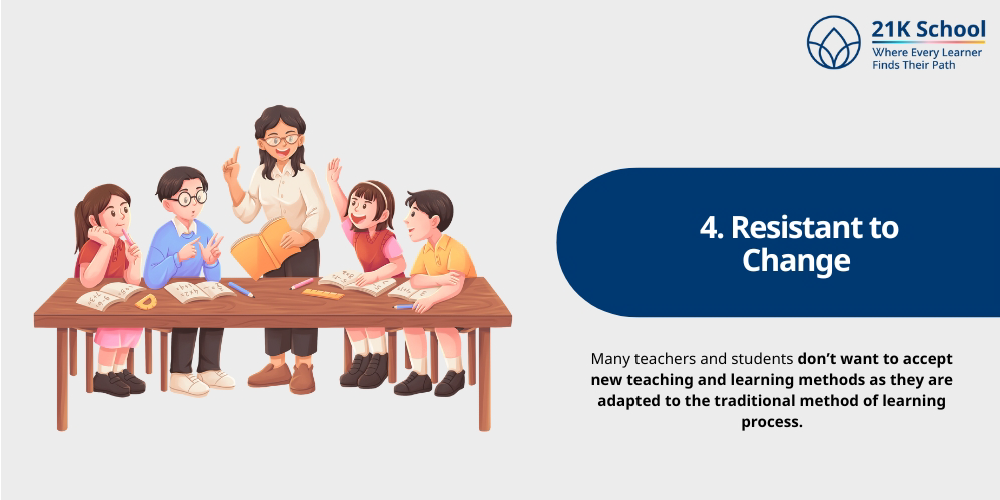
Resistance to change is the most common cause that hindrances the implementation of integrated learning.
Many teachers and students don’t want to accept new teaching and learning methods as they are adapted to the traditional method of learning process.
Changing to a new method is difficult for them due to which makes it difficult to grasp concepts more easily.
Even various schools and academies are prone to traditional methods of teaching and learning, and implementing new methods is limited to them.
Solution to Tackle the Problem of Resistance to Change
The problem of resistance to change can be eliminated through the use of interactive teaching and learning methods.
Even providing crash courses for upskilling students and teachers’ technical skills also helps in implementing integrated education.
Practical approaches, flexibility and real-world applications also help students to engage in interactive learning. Even allocating hybrid and blended learning approaches allows teachers to effectively teach their students.
5. Difficulties in Balancing Different Subjects
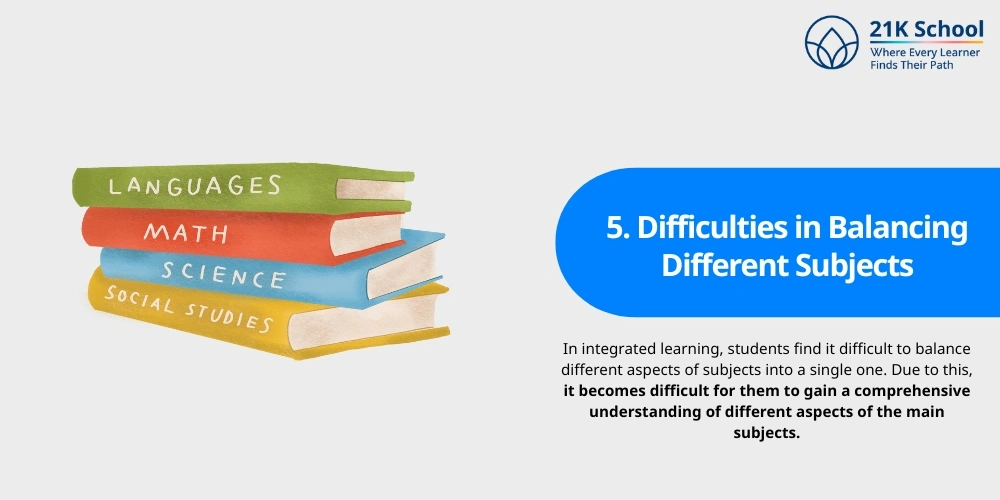
In integrated learning, students find it difficult to balance different aspects of subjects into a single one. Due to this, it becomes difficult for them to gain a comprehensive understanding of different aspects of the main subjects.
Due to this, students find it tough to balance both concepts and learn a single aspect in a single curriculum.
How to Tackle the Difficulties in Balancing Different Subjects
However, this problem can be avoided by making courses and subjects modular, which means it gives structure to the learning process.
A structured and foundational aspect helps students to grasp concepts more easily and relate different subjects into a single element.
Final Thoughts
A revolutionary approach to education integrates learning, promoting a comprehensive learning experience by highlighting the connections between different disciplines.
This approach fosters critical thinking, creativity and teamwork giving students the tools they need to successfully handle obstacles in the real world.
Though there are obstacles like time consumption, inadequate training for teachers, financial limitations, opposition to change and trouble juggling subjects.
These can be overcome with careful planning, continuous professional development and creative teaching techniques.
In the end, integrated learning is an essential part of contemporary education since it serves to improve student engagement and motivation while also preparing them for future employment prospects.

